Key takeaways:
- GDPR empowers individuals with the right to control their personal data through transparency and explicit consent.
- Organizations face challenges in compliance, such as obtaining proper consent and understanding data subject rights.
- Continuous effort and the adoption of technology are essential for ongoing GDPR compliance and accountability.
- Future trends indicate a shift towards greater accountability and potential harmonization of global data protection laws.
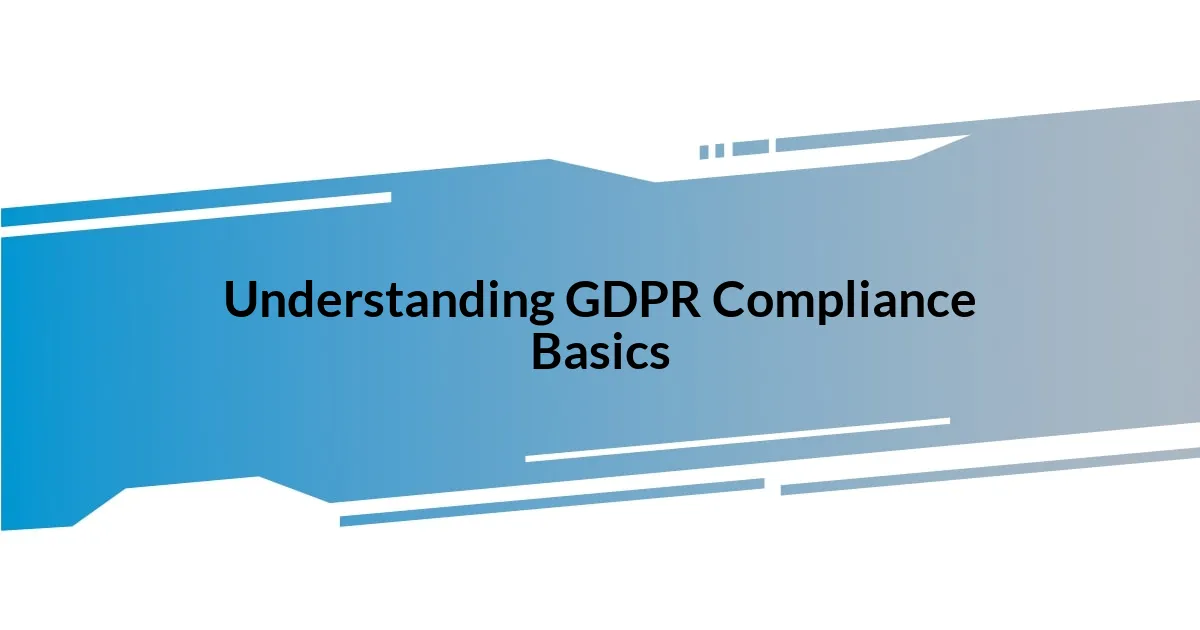
Understanding GDPR Compliance Basics
GDPR, or the General Data Protection Regulation, is a significant set of laws established by the European Union to protect personal data. I remember when I first delved into it, feeling overwhelmed by the sheer volume of regulations and technical jargon. But at its core, GDPR boils down to one critical principle: individuals have the right to control their personal data.
One of the most striking elements of GDPR compliance is the requirement for transparency. Companies must be upfront about how they collect, use, and store personal information. This brings to mind a moment in my career when I had to explain to a client the importance of clear data policies. It wasn’t just about following the law; it was about building trust with their customers. Wouldn’t you feel more secure sharing your information if you knew exactly how it would be used?
Moreover, the regulation emphasizes the concept of obtaining explicit consent before processing personal data. I recall grappling with the idea of consent forms during a project. It dawned on me that this isn’t just about ticking boxes; it’s about respecting people’s choices. Have you ever felt uneasy about giving your information? GDPR is here to ensure that your voice matters in the digital landscape.
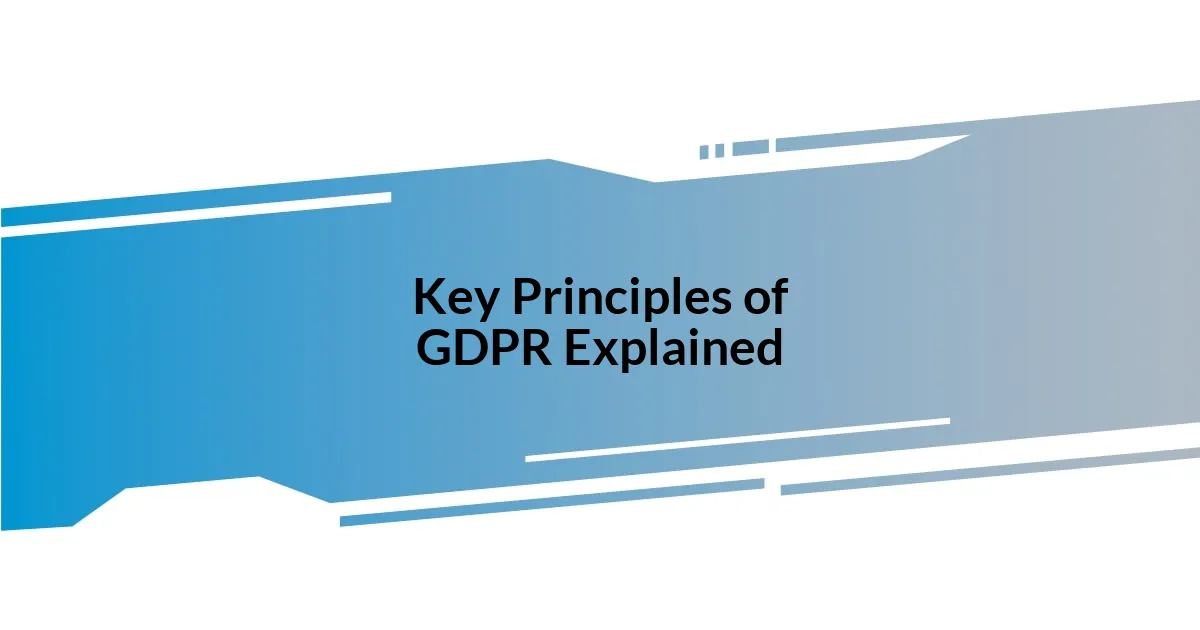
Key Principles of GDPR Explained
When I think about the key principles of GDPR, the first concept that stands out is the idea of data minimization. Organizations are encouraged to only collect and process data that is necessary for their specific purpose. I remember when I worked with a small business, helping them streamline their data collection strategies. We found that often, less truly is more; not only did it make their processes more efficient, but it also reassured their clients that their information wasn’t being used frivolously.
- Lawfulness, fairness, and transparency: Data should be processed legally and in a way that individuals can understand.
- Purpose limitation: Data must be collected for legitimate reasons and cannot be used for unrelated purposes later.
- Data accuracy: Organizations must keep personal data accurate and up to date, reflecting changes in individuals’ situations.
- Storage limitation: Data should only be kept as long as necessary for its intended purpose.
- Integrity and confidentiality: It’s essential to ensure that personal data is processed securely to protect against unauthorized access.
Thinking back to my experiences, I see how these principles not only shape compliance but also instill a sense of responsibility in organizations. They encourage companies to reflect on their data practices, ultimately benefiting both businesses and individuals.
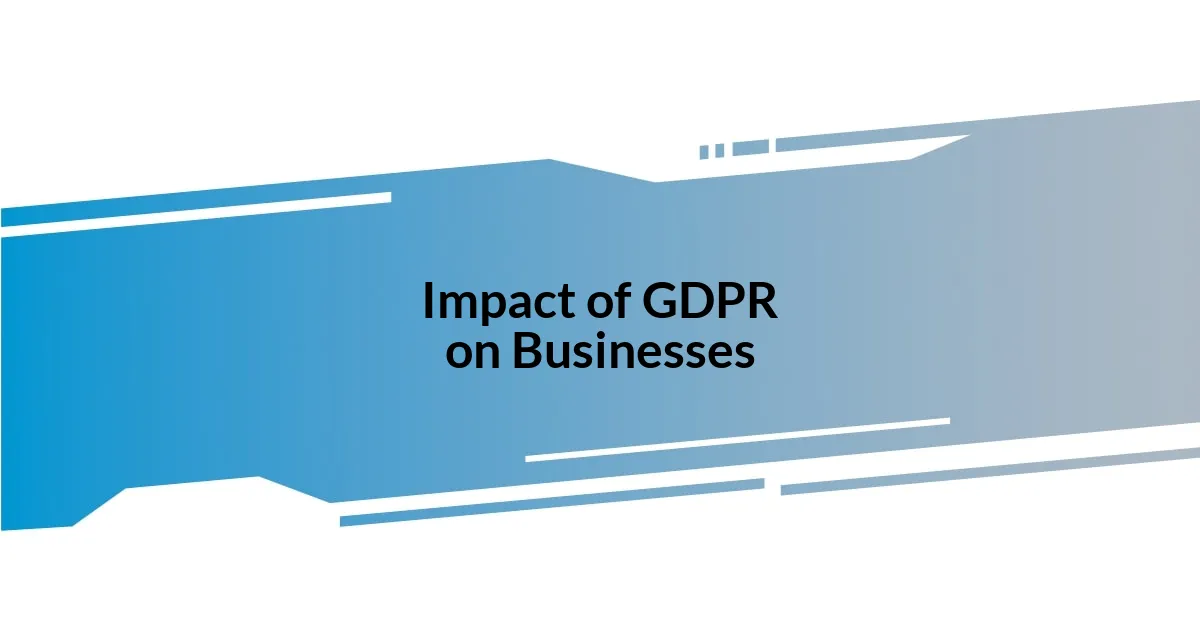
Impact of GDPR on Businesses
The impact of GDPR on businesses is profound and multifaceted. From my experience, I noticed that many organizations initially struggled with the compliance process, often feeling daunted by the legal ramifications. I recall advising a startup, and watching their stress turn into determination as they embraced GDPR not just as a set of rules but as an opportunity to enhance their data management practices. They found that being compliant was not just about following the law; it was about becoming more accountable and trustworthy in the eyes of their customers.
Another critical aspect is the financial implications. Many businesses had to invest significantly in training, legal consultations, and new technologies to ensure compliance. I once spoke with a small retail company that had to revamp its entire checkout system to accommodate GDPR requirements. They were apprehensive about the costs involved, but I shared my belief that this investment would lead to greater customer loyalty and ultimately boost their bottom line. Have you ever thought about how a commitment to ethics could open new doors for growth?
Lastly, the continuous monitoring and reporting obligations under GDPR create an ongoing effort that businesses must engage in. I’ve seen companies develop robust data protection strategies that not only meet compliance, but also become a part of their culture. It reminds me of a conference I attended, where a speaker emphasized that GDPR can actually drive innovation by compelling organizations to think differently about data. This transformative aspect is what truly excites me about the regulation’s long-term impact.
| Aspect | Impact |
|---|---|
| Compliance Efforts | Increased investment in training and technology |
| Financial Implications | Initial costs leading to potential long-term benefits |
| Customer Trust | Enhanced transparency leading to stronger customer relationships |
| Innovation | Encouragement to rethink data practices and strategies |
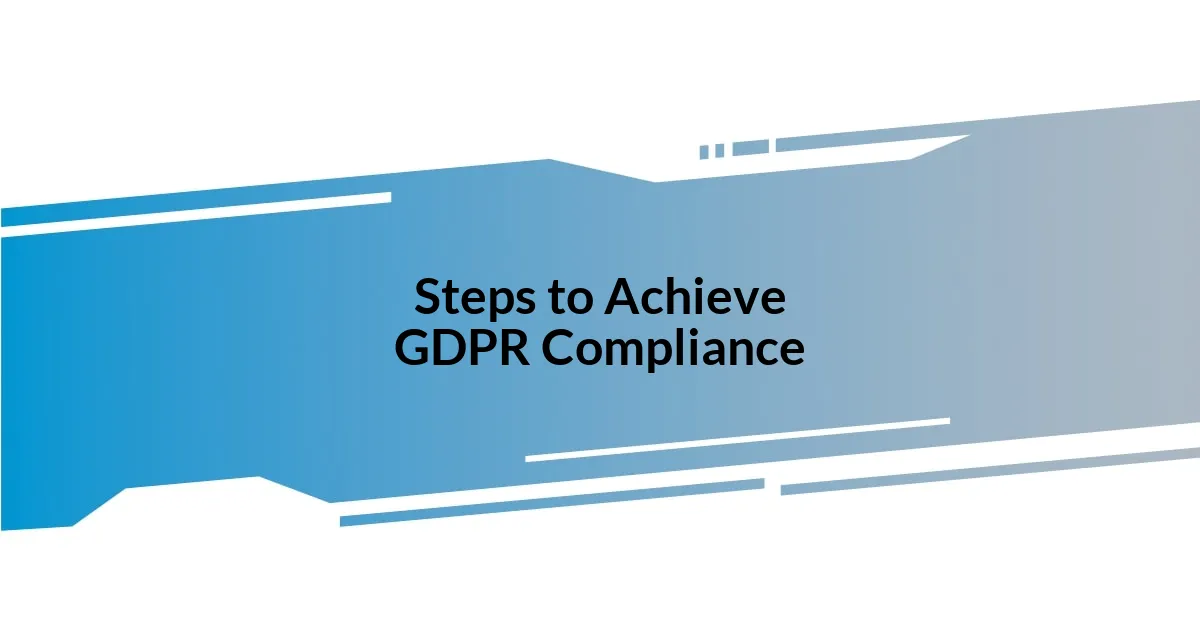
Steps to Achieve GDPR Compliance
Achieving GDPR compliance is a journey that requires careful planning and execution. In my experience, the first step involves conducting a thorough audit of your data collection practices. I remember working with a client who initially thought they had a solid data strategy. However, as we mapped out their processes, we uncovered numerous areas that needed improvement. It was eye-opening to see how a comprehensive audit could uncover inconsistencies and lead to better data handling.
Next, it’s vital to establish clear policies and procedures for managing personal data. This goes beyond simply writing a policy document; it requires a commitment to ongoing training and awareness among staff. I once facilitated a workshop where team members were encouraged to share their thoughts on data privacy. The discussion was enlightening and emphasized how important it is for everyone in the organization to feel responsible for data protection. Have you ever wondered how empowering your team can enhance compliance efforts?
Finally, implementing robust security measures is absolutely essential. I’ve seen firsthand how the right technology can make a world of difference in protecting sensitive information. One time, a small tech firm I advised integrated advanced encryption tools and access controls, leading to a dramatic reduction in security incidents. This not only helped them stay compliant but also built trust with their users. It’s a true testament to how proactive efforts can lead to both security and peace of mind.
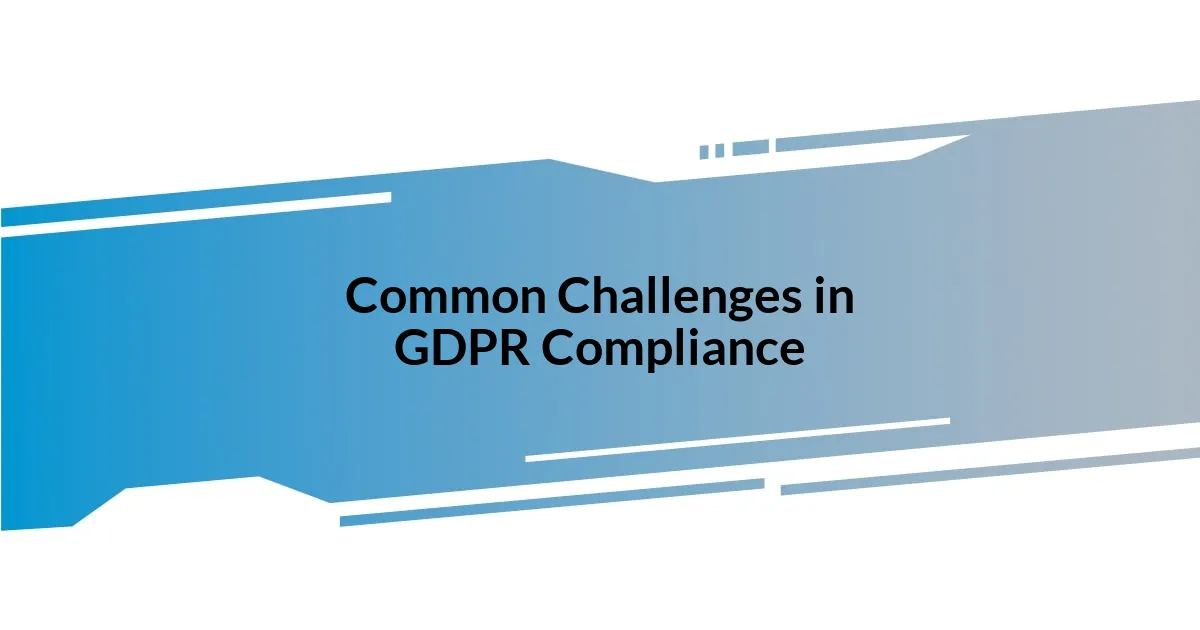
Common Challenges in GDPR Compliance
Navigating GDPR compliance can feel like an uphill battle for many organizations. For instance, a client of mine, a mid-sized online retailer, faced significant challenges when it came to obtaining proper consent from their users for data processing. They initially thought a generic consent checkbox would suffice, but as we dug deeper, we realized how vital it was to craft specific and clear consent requests. Have you ever considered how easy it might seem to comply until you begin to unpack the complexities?
Another common hurdle is the understanding and implementation of data subject rights. I remember working with a nonprofit organization that had difficulty handling requests for data access and deletion. They were overwhelmed by the process, feeling that every request was an unexpected burden. Through my guidance, we developed a streamlined approach that turned these demands into an opportunity for improved donor engagement. Isn’t it interesting how addressing compliance challenges can transform them into valuable connections?
Lastly, maintaining adequate documentation to demonstrate compliance can be an ongoing struggle. A small tech startup I consulted found it hard to keep their records organized amidst rapid growth and change. They felt as if every meeting, decision, and data processing activity was slipping through the cracks. By implementing a digital record-keeping system together, we not only simplified their documentation but also instilled a culture of accountability within the team. Can you imagine how much smoother operations could run when you have everything clearly outlined?

Best Practices for Ongoing Compliance
Staying compliant with GDPR isn’t a one-time effort; it requires continuous vigilance. One best practice that I highly recommend is to schedule regular compliance reviews. I once worked with a finance company that implemented quarterly evaluations of their data practices. Not only did this ensure they were always up to date with any regulatory changes, but it also fostered a culture of accountability within the team.
Another effective strategy is to leverage technology for monitoring and reporting. In my experience, automating certain compliance functions through data management tools can save significant time and minimize errors. I assisted a nonprofit in integrating such tools, and it was inspiring to see their stress levels decrease as the system handled reporting seamlessly. Have you ever thought about how embracing technology could simplify your compliance processes?
Finally, cultivating a culture of compliance is essential. I facilitated team-building activities focused on data protection that encouraged open discussions about privacy concerns. Witnessing the shift in my client’s team, where employees felt more empowered to ask questions and voice concerns about data handling, was truly rewarding. Isn’t it amazing how fostering a sense of ownership can enhance your entire organization’s compliance journey?
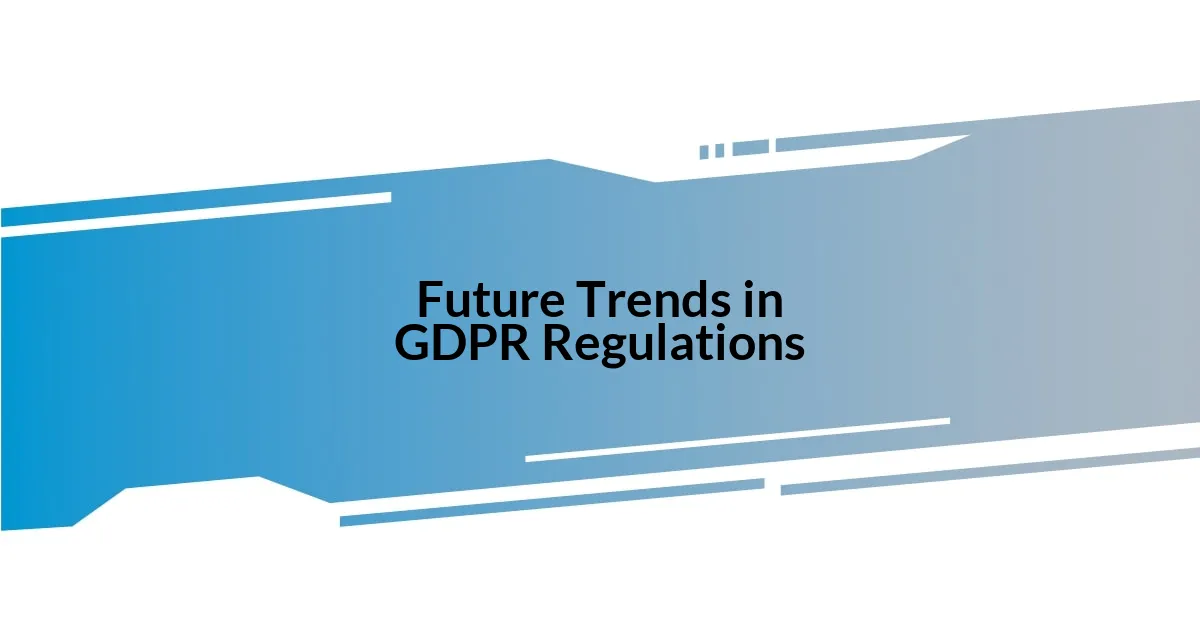
Future Trends in GDPR Regulations
The future of GDPR regulations seems poised for evolution as technological advancements continue to accelerate. I’ve observed that with the rise of artificial intelligence and machine learning, data processing can become even more complex. How do we balance innovation with the strict compliance mandates of GDPR? I believe that organizations will need to actively adapt their data handling practices. It’s essential to integrate privacy considerations right into the design of these technologies, otherwise, we may find ourselves facing even more stringent regulations down the line.
As the landscape of digital privacy evolves, I foresee an increased focus on accountability and transparency. For instance, when I collaborated with a fintech startup, they began to realize the importance of not just compliance, but also building trust with their customers. Their leadership decided to invest in transparency tools, which made a tangible difference in customer relations. Wouldn’t it be remarkable if regulators pushed for a shift from just punitive measures to encouraging positive actions around privacy? Organizations that proactively embrace this shift will likely stand out as leaders in their fields.
Moreover, we can expect a concerted global movement toward harmonizing data protection laws, which could mirror GDPR. Interestingly, during my discussions with international clients, I’ve noticed that many are eager to adopt similar standards. This trend could simplify cross-border data transactions and create a more uniform framework. Have you ever thought about how such harmonization could eliminate confusion and foster compliance? I genuinely feel that if we approach regulatory changes with an open mindset, we might just pave the way for a more secure digital landscape.